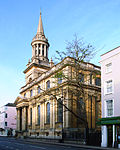| The High | |
 The High Street from St Mary's, looking east | |
 | |
| Location | Oxford, England |
|---|---|
| Postal code | OX1 |
| Coordinates | 51°45′09″N1°15′07″W / 51.7525°N 1.252°W |
| East end | Magdalen Bridge |
| West end | Carfax |
| South | M |
| Other | |
| Known for | Oxford colleges and buildings |
The High Street in Oxford, England, known locally as the High, runs between Carfax, generally seen as the centre of the city, and Magdalen Bridge to the east. [1]










